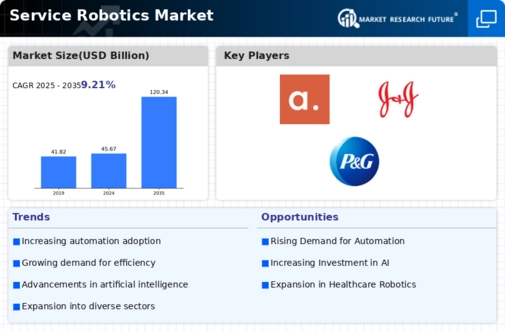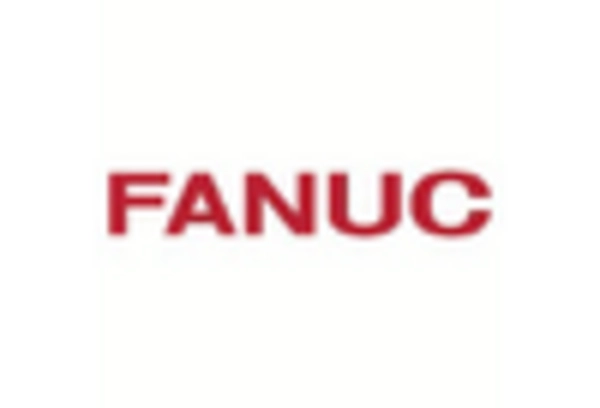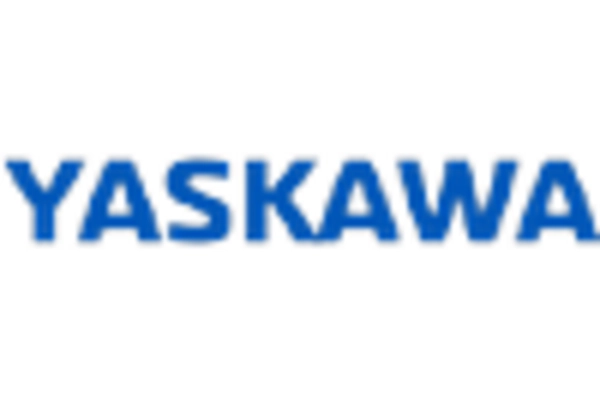-
EXECUTIVE SUMMARY
-
Market Overview
-
Key Findings
-
Market Segmentation
-
Competitive Landscape
-
Challenges and Opportunities
-
Future Outlook
-
MARKET INTRODUCTION
-
Definition
-
Scope of the study
- Research Objective
- Assumption
- Limitations
-
RESEARCH METHODOLOGY
-
Overview
-
Data Mining
-
Secondary Research
-
Primary Research
- Primary Interviews and Information Gathering Process
- Breakdown of Primary Respondents
-
Forecasting Model
-
Market Size Estimation
- Bottom-Up Approach
- Top-Down Approach
-
Data Triangulation
-
Validation
-
MARKET DYNAMICS
-
Overview
-
Drivers
-
Restraints
-
Opportunities
-
MARKET FACTOR ANALYSIS
-
Value chain Analysis
-
Porter's Five Forces Analysis
- Bargaining Power of Suppliers
- Bargaining Power of Buyers
- Threat of New Entrants
- Threat of Substitutes
- Intensity of Rivalry
-
COVID-19 Impact Analysis
- Market Impact Analysis
- Regional Impact
- Opportunity and Threat Analysis
-
SERVICE ROBOTICS MARKET, BY TYPE (USD BILLION)
-
Domestic
-
Professional
-
SERVICE ROBOTICS MARKET, BY END USER (USD BILLION)
-
Healthcare
-
Defense
-
Electronics
-
Automotive
-
Transportation
-
Construction
-
SERVICE ROBOTICS MARKET, BY REGIONAL (USD BILLION)
-
North America
- US
- Canada
-
Europe
- Germany
- UK
- France
- Russia
- Italy
- Spain
- Rest of Europe
-
APAC
- China
- India
- Japan
- South Korea
- Malaysia
- Thailand
- Indonesia
- Rest of APAC
-
South America
- Brazil
- Mexico
- Argentina
- Rest of South America
-
MEA
- GCC Countries
- South Africa
- Rest of MEA
-
COMPETITIVE LANDSCAPE
-
Overview
-
Competitive Analysis
-
Market share Analysis
-
Major Growth Strategy in the Service Robotics Market
-
Competitive Benchmarking
-
Leading Players in Terms of Number of Developments in the Service Robotics Market
-
Key developments and growth strategies
- New Product Launch/Service Deployment
- Merger & Acquisitions
- Joint Ventures
-
Major Players Financial Matrix
- Sales and Operating Income
- Major Players R&D Expenditure. 2023
-
COMPANY PROFILES
-
ABB
- Financial Overview
- Products Offered
- Key Developments
- SWOT Analysis
- Key Strategies
-
Intuitive Surgical
- Financial Overview
- Products Offered
- Key Developments
- SWOT Analysis
- Key Strategies
-
KUKA
- Financial Overview
- Products Offered
- Key Developments
- SWOT Analysis
- Key Strategies
-
SoftBank Robotics
- Financial Overview
- Products Offered
- Key Developments
- SWOT Analysis
- Key Strategies
-
Adept Technology
- Financial Overview
- Products Offered
- Key Developments
- SWOT Analysis
- Key Strategies
-
iRobot
- Financial Overview
- Products Offered
- Key Developments
- SWOT Analysis
- Key Strategies
-
Cyberdyne
- Financial Overview
- Products Offered
- Key Developments
- SWOT Analysis
- Key Strategies
-
Blue Ocean Robotics
- Financial Overview
- Products Offered
- Key Developments
- SWOT Analysis
- Key Strategies
-
Savioke
- Financial Overview
- Products Offered
- Key Developments
- SWOT Analysis
- Key Strategies
-
Honda
- Financial Overview
- Products Offered
- Key Developments
- SWOT Analysis
- Key Strategies
-
Teradyne
- Financial Overview
- Products Offered
- Key Developments
- SWOT Analysis
- Key Strategies
-
Yaskawa Electric
- Financial Overview
- Products Offered
- Key Developments
- SWOT Analysis
- Key Strategies
-
Fanuc
- Financial Overview
- Products Offered
- Key Developments
- SWOT Analysis
- Key Strategies
-
Nuro
- Financial Overview
- Products Offered
- Key Developments
- SWOT Analysis
- Key Strategies
-
Amazon Robotics
- Financial Overview
- Products Offered
- Key Developments
- SWOT Analysis
- Key Strategies
-
APPENDIX
-
References
-
Related Reports
-
LIST OF TABLES
-
LIST OF ASSUMPTIONS
-
NORTH AMERICA SERVICE ROBOTICS MARKET SIZE ESTIMATES & FORECAST, BY TYPE, 2019-2035 (USD BILLIONS)
-
NORTH AMERICA SERVICE ROBOTICS MARKET SIZE ESTIMATES & FORECAST, BY END USER, 2019-2035 (USD BILLIONS)
-
NORTH AMERICA SERVICE ROBOTICS MARKET SIZE ESTIMATES & FORECAST, BY REGIONAL, 2019-2035 (USD BILLIONS)
-
US SERVICE ROBOTICS MARKET SIZE ESTIMATES & FORECAST, BY TYPE, 2019-2035 (USD BILLIONS)
-
US SERVICE ROBOTICS MARKET SIZE ESTIMATES & FORECAST, BY END USER, 2019-2035 (USD BILLIONS)
-
US SERVICE ROBOTICS MARKET SIZE ESTIMATES & FORECAST, BY REGIONAL, 2019-2035 (USD BILLIONS)
-
CANADA SERVICE ROBOTICS MARKET SIZE ESTIMATES & FORECAST, BY TYPE, 2019-2035 (USD BILLIONS)
-
CANADA SERVICE ROBOTICS MARKET SIZE ESTIMATES & FORECAST, BY END USER, 2019-2035 (USD BILLIONS)
-
CANADA SERVICE ROBOTICS MARKET SIZE ESTIMATES & FORECAST, BY REGIONAL, 2019-2035 (USD BILLIONS)
-
EUROPE SERVICE ROBOTICS MARKET SIZE ESTIMATES & FORECAST, BY TYPE, 2019-2035 (USD BILLIONS)
-
EUROPE SERVICE ROBOTICS MARKET SIZE ESTIMATES & FORECAST, BY END USER, 2019-2035 (USD BILLIONS)
-
EUROPE SERVICE ROBOTICS MARKET SIZE ESTIMATES & FORECAST, BY REGIONAL, 2019-2035 (USD BILLIONS)
-
GERMANY SERVICE ROBOTICS MARKET SIZE ESTIMATES & FORECAST, BY TYPE, 2019-2035 (USD BILLIONS)
-
GERMANY SERVICE ROBOTICS MARKET SIZE ESTIMATES & FORECAST, BY END USER, 2019-2035 (USD BILLIONS)
-
GERMANY SERVICE ROBOTICS MARKET SIZE ESTIMATES & FORECAST, BY REGIONAL, 2019-2035 (USD BILLIONS)
-
UK SERVICE ROBOTICS MARKET SIZE ESTIMATES & FORECAST, BY TYPE, 2019-2035 (USD BILLIONS)
-
UK SERVICE ROBOTICS MARKET SIZE ESTIMATES & FORECAST, BY END USER, 2019-2035 (USD BILLIONS)
-
UK SERVICE ROBOTICS MARKET SIZE ESTIMATES & FORECAST, BY REGIONAL, 2019-2035 (USD BILLIONS)
-
FRANCE SERVICE ROBOTICS MARKET SIZE ESTIMATES & FORECAST, BY TYPE, 2019-2035 (USD BILLIONS)
-
FRANCE SERVICE ROBOTICS MARKET SIZE ESTIMATES & FORECAST, BY END USER, 2019-2035 (USD BILLIONS)
-
FRANCE SERVICE ROBOTICS MARKET SIZE ESTIMATES & FORECAST, BY REGIONAL, 2019-2035 (USD BILLIONS)
-
RUSSIA SERVICE ROBOTICS MARKET SIZE ESTIMATES & FORECAST, BY TYPE, 2019-2035 (USD BILLIONS)
-
RUSSIA SERVICE ROBOTICS MARKET SIZE ESTIMATES & FORECAST, BY END USER, 2019-2035 (USD BILLIONS)
-
RUSSIA SERVICE ROBOTICS MARKET SIZE ESTIMATES & FORECAST, BY REGIONAL, 2019-2035 (USD BILLIONS)
-
ITALY SERVICE ROBOTICS MARKET SIZE ESTIMATES & FORECAST, BY TYPE, 2019-2035 (USD BILLIONS)
-
ITALY SERVICE ROBOTICS MARKET SIZE ESTIMATES & FORECAST, BY END USER, 2019-2035 (USD BILLIONS)
-
ITALY SERVICE ROBOTICS MARKET SIZE ESTIMATES & FORECAST, BY REGIONAL, 2019-2035 (USD BILLIONS)
-
SPAIN SERVICE ROBOTICS MARKET SIZE ESTIMATES & FORECAST, BY TYPE, 2019-2035 (USD BILLIONS)
-
SPAIN SERVICE ROBOTICS MARKET SIZE ESTIMATES & FORECAST, BY END USER, 2019-2035 (USD BILLIONS)
-
SPAIN SERVICE ROBOTICS MARKET SIZE ESTIMATES & FORECAST, BY REGIONAL, 2019-2035 (USD BILLIONS)
-
REST OF EUROPE SERVICE ROBOTICS MARKET SIZE ESTIMATES & FORECAST, BY TYPE, 2019-2035 (USD BILLIONS)
-
REST OF EUROPE SERVICE ROBOTICS MARKET SIZE ESTIMATES & FORECAST, BY END USER, 2019-2035 (USD BILLIONS)
-
REST OF EUROPE SERVICE ROBOTICS MARKET SIZE ESTIMATES & FORECAST, BY REGIONAL, 2019-2035 (USD BILLIONS)
-
APAC SERVICE ROBOTICS MARKET SIZE ESTIMATES & FORECAST, BY TYPE, 2019-2035 (USD BILLIONS)
-
APAC SERVICE ROBOTICS MARKET SIZE ESTIMATES & FORECAST, BY END USER, 2019-2035 (USD BILLIONS)
-
APAC SERVICE ROBOTICS MARKET SIZE ESTIMATES & FORECAST, BY REGIONAL, 2019-2035 (USD BILLIONS)
-
CHINA SERVICE ROBOTICS MARKET SIZE ESTIMATES & FORECAST, BY TYPE, 2019-2035 (USD BILLIONS)
-
CHINA SERVICE ROBOTICS MARKET SIZE ESTIMATES & FORECAST, BY END USER, 2019-2035 (USD BILLIONS)
-
CHINA SERVICE ROBOTICS MARKET SIZE ESTIMATES & FORECAST, BY REGIONAL, 2019-2035 (USD BILLIONS)
-
INDIA SERVICE ROBOTICS MARKET SIZE ESTIMATES & FORECAST, BY TYPE, 2019-2035 (USD BILLIONS)
-
INDIA SERVICE ROBOTICS MARKET SIZE ESTIMATES & FORECAST, BY END USER, 2019-2035 (USD BILLIONS)
-
INDIA SERVICE ROBOTICS MARKET SIZE ESTIMATES & FORECAST, BY REGIONAL, 2019-2035 (USD BILLIONS)
-
JAPAN SERVICE ROBOTICS MARKET SIZE ESTIMATES & FORECAST, BY TYPE, 2019-2035 (USD BILLIONS)
-
JAPAN SERVICE ROBOTICS MARKET SIZE ESTIMATES & FORECAST, BY END USER, 2019-2035 (USD BILLIONS)
-
JAPAN SERVICE ROBOTICS MARKET SIZE ESTIMATES & FORECAST, BY REGIONAL, 2019-2035 (USD BILLIONS)
-
SOUTH KOREA SERVICE ROBOTICS MARKET SIZE ESTIMATES & FORECAST, BY TYPE, 2019-2035 (USD BILLIONS)
-
SOUTH KOREA SERVICE ROBOTICS MARKET SIZE ESTIMATES & FORECAST, BY END USER, 2019-2035 (USD BILLIONS)
-
SOUTH KOREA SERVICE ROBOTICS MARKET SIZE ESTIMATES & FORECAST, BY REGIONAL, 2019-2035 (USD BILLIONS)
-
MALAYSIA SERVICE ROBOTICS MARKET SIZE ESTIMATES & FORECAST, BY TYPE, 2019-2035 (USD BILLIONS)
-
MALAYSIA SERVICE ROBOTICS MARKET SIZE ESTIMATES & FORECAST, BY END USER, 2019-2035 (USD BILLIONS)
-
MALAYSIA SERVICE ROBOTICS MARKET SIZE ESTIMATES & FORECAST, BY REGIONAL, 2019-2035 (USD BILLIONS)
-
THAILAND SERVICE ROBOTICS MARKET SIZE ESTIMATES & FORECAST, BY TYPE, 2019-2035 (USD BILLIONS)
-
THAILAND SERVICE ROBOTICS MARKET SIZE ESTIMATES & FORECAST, BY END USER, 2019-2035 (USD BILLIONS)
-
THAILAND SERVICE ROBOTICS MARKET SIZE ESTIMATES & FORECAST, BY REGIONAL, 2019-2035 (USD BILLIONS)
-
INDONESIA SERVICE ROBOTICS MARKET SIZE ESTIMATES & FORECAST, BY TYPE, 2019-2035 (USD BILLIONS)
-
INDONESIA SERVICE ROBOTICS MARKET SIZE ESTIMATES & FORECAST, BY END USER, 2019-2035 (USD BILLIONS)
-
INDONESIA SERVICE ROBOTICS MARKET SIZE ESTIMATES & FORECAST, BY REGIONAL, 2019-2035 (USD BILLIONS)
-
REST OF APAC SERVICE ROBOTICS MARKET SIZE ESTIMATES & FORECAST, BY TYPE, 2019-2035 (USD BILLIONS)
-
REST OF APAC SERVICE ROBOTICS MARKET SIZE ESTIMATES & FORECAST, BY END USER, 2019-2035 (USD BILLIONS)
-
REST OF APAC SERVICE ROBOTICS MARKET SIZE ESTIMATES & FORECAST, BY REGIONAL, 2019-2035 (USD BILLIONS)
-
SOUTH AMERICA SERVICE ROBOTICS MARKET SIZE ESTIMATES & FORECAST, BY TYPE, 2019-2035 (USD BILLIONS)
-
SOUTH AMERICA SERVICE ROBOTICS MARKET SIZE ESTIMATES & FORECAST, BY END USER, 2019-2035 (USD BILLIONS)
-
SOUTH AMERICA SERVICE ROBOTICS MARKET SIZE ESTIMATES & FORECAST, BY REGIONAL, 2019-2035 (USD BILLIONS)
-
BRAZIL SERVICE ROBOTICS MARKET SIZE ESTIMATES & FORECAST, BY TYPE, 2019-2035 (USD BILLIONS)
-
BRAZIL SERVICE ROBOTICS MARKET SIZE ESTIMATES & FORECAST, BY END USER, 2019-2035 (USD BILLIONS)
-
BRAZIL SERVICE ROBOTICS MARKET SIZE ESTIMATES & FORECAST, BY REGIONAL, 2019-2035 (USD BILLIONS)
-
MEXICO SERVICE ROBOTICS MARKET SIZE ESTIMATES & FORECAST, BY TYPE, 2019-2035 (USD BILLIONS)
-
MEXICO SERVICE ROBOTICS MARKET SIZE ESTIMATES & FORECAST, BY END USER, 2019-2035 (USD BILLIONS)
-
MEXICO SERVICE ROBOTICS MARKET SIZE ESTIMATES & FORECAST, BY REGIONAL, 2019-2035 (USD BILLIONS)
-
ARGENTINA SERVICE ROBOTICS MARKET SIZE ESTIMATES & FORECAST, BY TYPE, 2019-2035 (USD BILLIONS)
-
ARGENTINA SERVICE ROBOTICS MARKET SIZE ESTIMATES & FORECAST, BY END USER, 2019-2035 (USD BILLIONS)
-
ARGENTINA SERVICE ROBOTICS MARKET SIZE ESTIMATES & FORECAST, BY REGIONAL, 2019-2035 (USD BILLIONS)
-
REST OF SOUTH AMERICA SERVICE ROBOTICS MARKET SIZE ESTIMATES & FORECAST, BY TYPE, 2019-2035 (USD BILLIONS)
-
REST OF SOUTH AMERICA SERVICE ROBOTICS MARKET SIZE ESTIMATES & FORECAST, BY END USER, 2019-2035 (USD BILLIONS)
-
REST OF SOUTH AMERICA SERVICE ROBOTICS MARKET SIZE ESTIMATES & FORECAST, BY REGIONAL, 2019-2035 (USD BILLIONS)
-
MEA SERVICE ROBOTICS MARKET SIZE ESTIMATES & FORECAST, BY TYPE, 2019-2035 (USD BILLIONS)
-
MEA SERVICE ROBOTICS MARKET SIZE ESTIMATES & FORECAST, BY END USER, 2019-2035 (USD BILLIONS)
-
MEA SERVICE ROBOTICS MARKET SIZE ESTIMATES & FORECAST, BY REGIONAL, 2019-2035 (USD BILLIONS)
-
GCC COUNTRIES SERVICE ROBOTICS MARKET SIZE ESTIMATES & FORECAST, BY TYPE, 2019-2035 (USD BILLIONS)
-
GCC COUNTRIES SERVICE ROBOTICS MARKET SIZE ESTIMATES & FORECAST, BY END USER, 2019-2035 (USD BILLIONS)
-
GCC COUNTRIES SERVICE ROBOTICS MARKET SIZE ESTIMATES & FORECAST, BY REGIONAL, 2019-2035 (USD BILLIONS)
-
SOUTH AFRICA SERVICE ROBOTICS MARKET SIZE ESTIMATES & FORECAST, BY TYPE, 2019-2035 (USD BILLIONS)
-
SOUTH AFRICA SERVICE ROBOTICS MARKET SIZE ESTIMATES & FORECAST, BY END USER, 2019-2035 (USD BILLIONS)
-
SOUTH AFRICA SERVICE ROBOTICS MARKET SIZE ESTIMATES & FORECAST, BY REGIONAL, 2019-2035 (USD BILLIONS)
-
REST OF MEA SERVICE ROBOTICS MARKET SIZE ESTIMATES & FORECAST, BY TYPE, 2019-2035 (USD BILLIONS)
-
REST OF MEA SERVICE ROBOTICS MARKET SIZE ESTIMATES & FORECAST, BY END USER, 2019-2035 (USD BILLIONS)
-
REST OF MEA SERVICE ROBOTICS MARKET SIZE ESTIMATES & FORECAST, BY REGIONAL, 2019-2035 (USD BILLIONS)
-
PRODUCT LAUNCH/PRODUCT DEVELOPMENT/APPROVAL
-
ACQUISITION/PARTNERSHIP
-
LIST OF FIGURES
-
MARKET SYNOPSIS
-
NORTH AMERICA SERVICE ROBOTICS MARKET ANALYSIS
-
US SERVICE ROBOTICS MARKET ANALYSIS BY TYPE
-
US SERVICE ROBOTICS MARKET ANALYSIS BY END USER
-
US SERVICE ROBOTICS MARKET ANALYSIS BY REGIONAL
-
CANADA SERVICE ROBOTICS MARKET ANALYSIS BY TYPE
-
CANADA SERVICE ROBOTICS MARKET ANALYSIS BY END USER
-
CANADA SERVICE ROBOTICS MARKET ANALYSIS BY REGIONAL
-
EUROPE SERVICE ROBOTICS MARKET ANALYSIS
-
GERMANY SERVICE ROBOTICS MARKET ANALYSIS BY TYPE
-
GERMANY SERVICE ROBOTICS MARKET ANALYSIS BY END USER
-
GERMANY SERVICE ROBOTICS MARKET ANALYSIS BY REGIONAL
-
UK SERVICE ROBOTICS MARKET ANALYSIS BY TYPE
-
UK SERVICE ROBOTICS MARKET ANALYSIS BY END USER
-
UK SERVICE ROBOTICS MARKET ANALYSIS BY REGIONAL
-
FRANCE SERVICE ROBOTICS MARKET ANALYSIS BY TYPE
-
FRANCE SERVICE ROBOTICS MARKET ANALYSIS BY END USER
-
FRANCE SERVICE ROBOTICS MARKET ANALYSIS BY REGIONAL
-
RUSSIA SERVICE ROBOTICS MARKET ANALYSIS BY TYPE
-
RUSSIA SERVICE ROBOTICS MARKET ANALYSIS BY END USER
-
RUSSIA SERVICE ROBOTICS MARKET ANALYSIS BY REGIONAL
-
ITALY SERVICE ROBOTICS MARKET ANALYSIS BY TYPE
-
ITALY SERVICE ROBOTICS MARKET ANALYSIS BY END USER
-
ITALY SERVICE ROBOTICS MARKET ANALYSIS BY REGIONAL
-
SPAIN SERVICE ROBOTICS MARKET ANALYSIS BY TYPE
-
SPAIN SERVICE ROBOTICS MARKET ANALYSIS BY END USER
-
SPAIN SERVICE ROBOTICS MARKET ANALYSIS BY REGIONAL
-
REST OF EUROPE SERVICE ROBOTICS MARKET ANALYSIS BY TYPE
-
REST OF EUROPE SERVICE ROBOTICS MARKET ANALYSIS BY END USER
-
REST OF EUROPE SERVICE ROBOTICS MARKET ANALYSIS BY REGIONAL
-
APAC SERVICE ROBOTICS MARKET ANALYSIS
-
CHINA SERVICE ROBOTICS MARKET ANALYSIS BY TYPE
-
CHINA SERVICE ROBOTICS MARKET ANALYSIS BY END USER
-
CHINA SERVICE ROBOTICS MARKET ANALYSIS BY REGIONAL
-
INDIA SERVICE ROBOTICS MARKET ANALYSIS BY TYPE
-
INDIA SERVICE ROBOTICS MARKET ANALYSIS BY END USER
-
INDIA SERVICE ROBOTICS MARKET ANALYSIS BY REGIONAL
-
JAPAN SERVICE ROBOTICS MARKET ANALYSIS BY TYPE
-
JAPAN SERVICE ROBOTICS MARKET ANALYSIS BY END USER
-
JAPAN SERVICE ROBOTICS MARKET ANALYSIS BY REGIONAL
-
SOUTH KOREA SERVICE ROBOTICS MARKET ANALYSIS BY TYPE
-
SOUTH KOREA SERVICE ROBOTICS MARKET ANALYSIS BY END USER
-
SOUTH KOREA SERVICE ROBOTICS MARKET ANALYSIS BY REGIONAL
-
MALAYSIA SERVICE ROBOTICS MARKET ANALYSIS BY TYPE
-
MALAYSIA SERVICE ROBOTICS MARKET ANALYSIS BY END USER
-
MALAYSIA SERVICE ROBOTICS MARKET ANALYSIS BY REGIONAL
-
THAILAND SERVICE ROBOTICS MARKET ANALYSIS BY TYPE
-
THAILAND SERVICE ROBOTICS MARKET ANALYSIS BY END USER
-
THAILAND SERVICE ROBOTICS MARKET ANALYSIS BY REGIONAL
-
INDONESIA SERVICE ROBOTICS MARKET ANALYSIS BY TYPE
-
INDONESIA SERVICE ROBOTICS MARKET ANALYSIS BY END USER
-
INDONESIA SERVICE ROBOTICS MARKET ANALYSIS BY REGIONAL
-
REST OF APAC SERVICE ROBOTICS MARKET ANALYSIS BY TYPE
-
REST OF APAC SERVICE ROBOTICS MARKET ANALYSIS BY END USER
-
REST OF APAC SERVICE ROBOTICS MARKET ANALYSIS BY REGIONAL
-
SOUTH AMERICA SERVICE ROBOTICS MARKET ANALYSIS
-
BRAZIL SERVICE ROBOTICS MARKET ANALYSIS BY TYPE
-
BRAZIL SERVICE ROBOTICS MARKET ANALYSIS BY END USER
-
BRAZIL SERVICE ROBOTICS MARKET ANALYSIS BY REGIONAL
-
MEXICO SERVICE ROBOTICS MARKET ANALYSIS BY TYPE
-
MEXICO SERVICE ROBOTICS MARKET ANALYSIS BY END USER
-
MEXICO SERVICE ROBOTICS MARKET ANALYSIS BY REGIONAL
-
ARGENTINA SERVICE ROBOTICS MARKET ANALYSIS BY TYPE
-
ARGENTINA SERVICE ROBOTICS MARKET ANALYSIS BY END USER
-
ARGENTINA SERVICE ROBOTICS MARKET ANALYSIS BY REGIONAL
-
REST OF SOUTH AMERICA SERVICE ROBOTICS MARKET ANALYSIS BY TYPE
-
REST OF SOUTH AMERICA SERVICE ROBOTICS MARKET ANALYSIS BY END USER
-
REST OF SOUTH AMERICA SERVICE ROBOTICS MARKET ANALYSIS BY REGIONAL
-
MEA SERVICE ROBOTICS MARKET ANALYSIS
-
GCC COUNTRIES SERVICE ROBOTICS MARKET ANALYSIS BY TYPE
-
GCC COUNTRIES SERVICE ROBOTICS MARKET ANALYSIS BY END USER
-
GCC COUNTRIES SERVICE ROBOTICS MARKET ANALYSIS BY REGIONAL
-
SOUTH AFRICA SERVICE ROBOTICS MARKET ANALYSIS BY TYPE
-
SOUTH AFRICA SERVICE ROBOTICS MARKET ANALYSIS BY END USER
-
SOUTH AFRICA SERVICE ROBOTICS MARKET ANALYSIS BY REGIONAL
-
REST OF MEA SERVICE ROBOTICS MARKET ANALYSIS BY TYPE
-
REST OF MEA SERVICE ROBOTICS MARKET ANALYSIS BY END USER
-
REST OF MEA SERVICE ROBOTICS MARKET ANALYSIS BY REGIONAL
-
KEY BUYING CRITERIA OF SERVICE ROBOTICS MARKET
-
RESEARCH PROCESS OF MRFR
-
DRO ANALYSIS OF SERVICE ROBOTICS MARKET
-
DRIVERS IMPACT ANALYSIS: SERVICE ROBOTICS MARKET
-
RESTRAINTS IMPACT ANALYSIS: SERVICE ROBOTICS MARKET
-
SUPPLY / VALUE CHAIN: SERVICE ROBOTICS MARKET
-
SERVICE ROBOTICS MARKET, BY TYPE, 2025 (% SHARE)
-
SERVICE ROBOTICS MARKET, BY TYPE, 2019 TO 2035 (USD Billions)
-
SERVICE ROBOTICS MARKET, BY END USER, 2025 (% SHARE)
-
SERVICE ROBOTICS MARKET, BY END USER, 2019 TO 2035 (USD Billions)
-
SERVICE ROBOTICS MARKET, BY REGIONAL, 2025 (% SHARE)
-
SERVICE ROBOTICS MARKET, BY REGIONAL, 2019 TO 2035 (USD Billions)
-
BENCHMARKING OF MAJOR COMPETITORS
-
"
















Leave a Comment